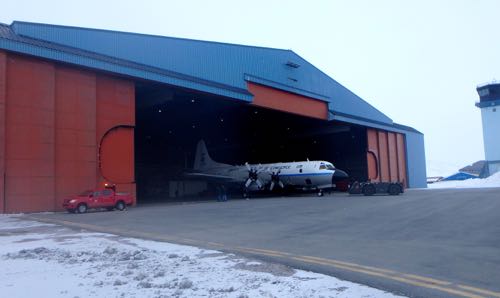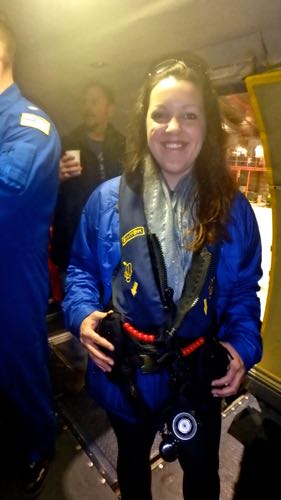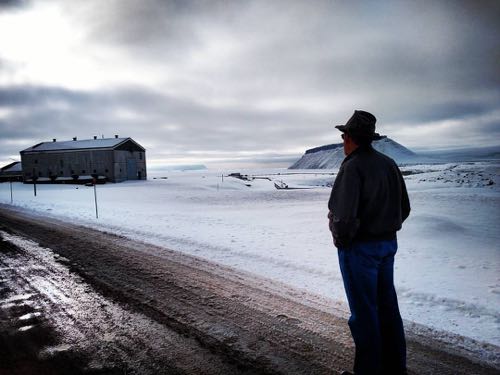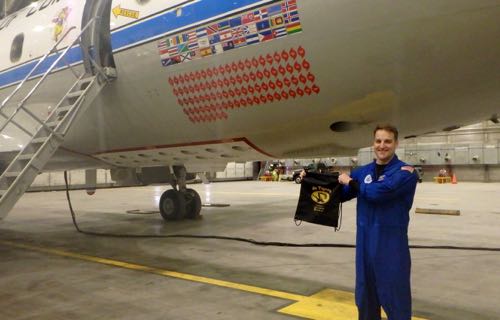Waking up this morning at the break of dawn (is it considered dawn when there is no sunrise or sunset?) was easy to do with thoughts of our first science flight buzzing in my head. I had packed my bag the night before: cameras, laptop, noise cancelling headphones, extra layers, classroom flags, passport. I stopped at the dining hall to grab a quick breakfast and stock up on human fuel for the plane ride and then power-walked to the hangar for my 7 a.m. safety briefing. But, as it goes with airborne science, the weather changed and our flight was scrubbed. Monitoring the satellite data and models to ensure we have a successful safe flight is a 24/7 job and the weather patterns, especially in the Arctic, can change at any given moment. For that reason, no flight is officially on until the 6:30 a.m. weather meeting. We're looking forward to completing a priority sea ice flight tomorrow once the weather is clearer!

The scrubbed mission did not mean we would put off our safety and emergency training. Every new person on board a NOAA P3 must participate in emergency and survival training. Each of us completed an online aviation safety and survival training before coming to Thule, but we also needed to go through a physical briefing. NOAA Pilot Nathan Kahn led myself, ATM Engineer Richard Mitchell, and NASA Producer Jefferson Beck through standard and emergency procedures. The briefing was thorough and covered everything from the seat belt required in the P3, location of emergency supplies, to detailed emergency procedures.
In this photo, I am trying on a life vest equipped with a personal beacon or GPSA Global Positioning System (GPS) is a satellite-based navigation system used to track the location or position of objects on the Earth’s surface. system. Tomorrow we will be completing a 'ditch' drill in which we will practice putting on our Gumby Suits before the life vests. This is the procedure in the case that the plane needs to drop to water and we would 'ditch' the plane for a life raft. I'll take you through the details of the procedure after we complete the drill.

After completing the safety training, I had the opportunity to ask our pilots a little bit about their day job (flying into hurricanes). Many who have been following the blogs are attended our pre-field talk at Our Lady of Lourdes, have heard about Miss Piggy and her ventures through hurricanes in the name of science, most recently Hurricane Patricia. I'd like to do a feature on some of these stories in the coming days so stay tuned! It's interesting to learn about the different instruments used on Miss Piggy for Hurricane science vs Ice science, not to mention what it feels like for a pilot to fly in and out of some of the strongest storms in history.
There is a lot of "groundwork" that happens throughout an airborne science mission. We ended our day with the usual pre-flight evening meeting. Tomorrow's agenda includes the "North Pole Transect" and hopefully weather will remain clear enough to complete that flight. Then Richard (ATM engineer) and I headed to the ground station to download low rate GPSA Global Positioning System (GPS) is a satellite-based navigation system used to track the location or position of objects on the Earth’s surface. data. Even though there was no flight today, the GPSA Global Positioning System (GPS) is a satellite-based navigation system used to track the location or position of objects on the Earth’s surface. station is constantly collecting data. Richard downloads the data of the day onto a flash drive, which John Sonntag uses to make sure the GPSA Global Positioning System (GPS) is a satellite-based navigation system used to track the location or position of objects on the Earth’s surface. instruments on the plane are calibrated and to correct for any error in signal.
The trip to the ground station, located right on the coast of North Star Bay is a beautiful walk. Check out the view from our trip below. We are entering mud season here in Thule which means heavy melting and (you guessed it) lots of mud. Every shop and building has a box of plastic 'booties' to place over your shoes when you enter because the mud is that bad, and it has been sounding like rain outside constantly just from the dripping of melting snow and icicles. You can see muddy road leading to the ground station in the photo below.

Tomorrow we will be plane-side by 7:15 a.m. and hopefully out on a science flight by 8!
Today's Post Brought to You By Southern Columbia School in Catawissa, PA (Hello to Mrs. Bloom's 2nd Grade Class!)



Comments